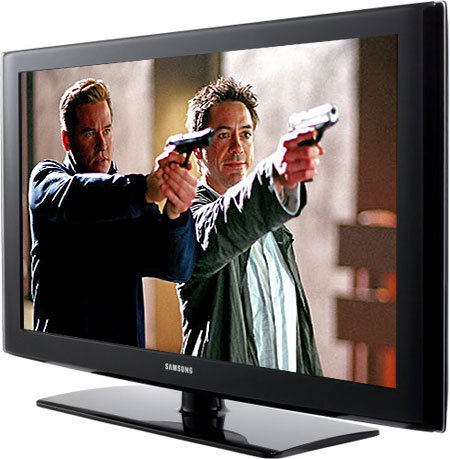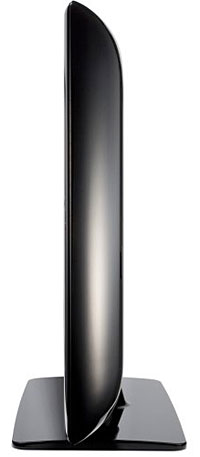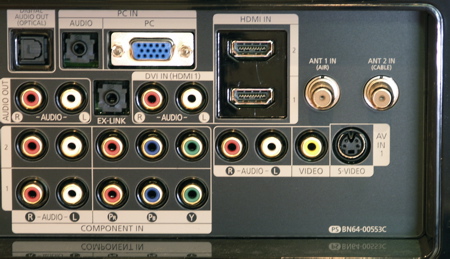Samsung LN-T5265F LCD HDTV
I have to admit, I had some trepidation going into this review. The track record for Samsung's flat panels has not been that great. Like all Samsung products, nevertheless, they have come a long way in a very short time. So when Samsung's TV test manager and HT alum Mike Wood recommend I check out the company's new LN-T5265F LCD flat panel ($3,999 Minimum Advertised Price), I begrudgingly agreed. If you'll remember, Samsung's HL-S6188W won our last RPTV Face Off, its predecessor finishing mid-pack the year before. Perhaps this LCD would make a similar jump. We shall see.

Cleaning Up the Look
Samsung has sold a lot of TVs in the past few years with a somewhat angular look. The latest models, however, offer a swoopier design that would look more upscale if not for the cheap-looking plastic.
The remote is standard Samsung, with Braille and all. There is a glow-in-the-dark button that lights up five others. This is just how you want a remote to work, but why only five buttons? Ironically, four of the buttons are different in size from the others, so they'd be the ones you could find in the dark. Oh well.
 Likewise, the menus are standard Samsung. With each generation of Samsung displays, there are more and more options to tweak the video. This is always a good trend. On the LN-T5265F, in fact, you can even adjust gamma and calibrate the gray scale all within the user menu. The menu moves a little slower than I remember of their other TVs.
Likewise, the menus are standard Samsung. With each generation of Samsung displays, there are more and more options to tweak the video. This is always a good trend. On the LN-T5265F, in fact, you can even adjust gamma and calibrate the gray scale all within the user menu. The menu moves a little slower than I remember of their other TVs.
Color
There are many reasons why a display will have the color points it does. Perhaps marketing wants the ability to say "125 percent of the HDTV standard" or other such nonsense. Or it could be a light output issue. Accurate color points often mean less light output, which can mean trouble in a lineup on a brightly lit sales floor. Believe it or not, there are very few reasons (from a manufacturer's point of view) for a display to have accurate color points. If you were to show the average person a display with wildly oversaturated color points and one with accurate color points, often they'll choose the "wow" factor, oversaturated display. At least, they will at first.
In the long run, accurate color is far more pleasing to watch. Everything just looks more natural. On a display with inaccurate color, even to the untrained eye, certain things like grass, skin tones, and food will be noticeably (but perhaps subtly) off.

So when a company releases a display that has accurate color points, I like to give it extra props for bucking the trend. By taking a gander at the measurements graph, you'll see that the LN-T5265F has just about spot-on color points when in Auto Color Gamut mode. These are pretty much within the measurement error of our Photo Research PR-650 and much too close for the human eye to distinguish from perfectly accurate.
The result is pleasingly natural. HD movies like 16 Blocks, with its somewhat muted color palette, never looked washed out. And skin tones never looked reddish or otherwise sunburned. Skin tones on The Phantom of the Opera were warm and realistic, with the many colors of the sets and costumes always looking natural and never over-rich. And, if you still want that oversaturated look, you can switch from Auto Color Gamut mode to Wide mode.
 Not that there is any use for it yet, but this TV actually will do something with xvYCC. This may come in handy if we ever have anything that will take advantage of that (maybe a PS3 game, if we're lucky).
Not that there is any use for it yet, but this TV actually will do something with xvYCC. This may come in handy if we ever have anything that will take advantage of that (maybe a PS3 game, if we're lucky).
It is interesting to note that nearly all of the displays in the past few years with accurate color points have been from Samsung.
Processing
The Samsung LN-T5265F will accept 1080p/60 over HDMI (1.3), PC RGB, and even component. With Samsung's own BD-P1200 Blu-ray player, you can't choose the 24p output when connected to this TV; yet, with Sony's BDP-S300, the 24p works just fine. What we've got here is...failure to communicate. Samsung claims that newer samples don't have this issue, and they're looking into an update to get the older samples to work. Keep in mind that, with a 60-hertz display, this doesn't really matter.
With DVDs, the LN-T5265F seemed to fail all deinterlacing tests. Oddly, you have to turn on Film Mode processing, which is buried on the second page of the Setup menu (not in the Picture menu where you'd expect to find it). After turning this on, it picks up the 3:2 sequence with 480i quickly with both the Silicon Optix HQV Benchmark DVD, as well as with the Gladiator DVD. Like most displays, it doesn't pick up 3:2 with 1080i signals. The rotating bar and the flag-waving scene from the HQV Benchmark exhibited noticeable jagged edges. I'd call these tests below average and about average, respectively.
 However, the display upconverts DVDs very well. With our customary Fifth Element DVD demo, the LN-T5265F pulled a substantial amount of detail from the image. It was better, in fact, than most upconverting DVD players. However, the cost of all that detail is a fair amount of noise. Enabling the built-in noise reduction helps alleviate this to some extent, but it also alleviates you of that extra detail.
However, the display upconverts DVDs very well. With our customary Fifth Element DVD demo, the LN-T5265F pulled a substantial amount of detail from the image. It was better, in fact, than most upconverting DVD players. However, the cost of all that detail is a fair amount of noise. Enabling the built-in noise reduction helps alleviate this to some extent, but it also alleviates you of that extra detail.
The LN-T5265F does not fully resolve a one-pixel-on/one-pixel-off pattern with component, but it's close. In another processing oddity, when you enable the pixel-for-pixel Just Scan mode, it seems to fail the 1080i deinterlacing test. But if you use HDMI, it can resolve the pattern perfectly, and the Just Scan mode passes the 1080i deinterlacing test. Weird.... Oh yeah, and in Movie mode, there's mercifully no DNIe processing, just like Samsung's RPTVs.
Contrast Ratio
At 1,155:1, the LN-T5265F's contrast ratio is better than average, but not quite as good as the best we've seen. It's above average for an LCD, although most plasmas will have a better real-world contrast ratio. ANSI contrast, as with most LCDs, is nearly identical at 1,142:1. At its lowest backlight setting, the black level is 0.017 foot-lamberts. Some plasmas, a couple of LCDs, and many rear-projection displays are lower; but for a flat panel, this is quite good. On the other end of the range, at the 10 backlight setting, you can reach a blazing 105.5 ftL.
It Sure Is an LCD
Like most 60-Hz LCDs, there is a fair amount of motion blur. Anything on the screen that moves above a certain speed appears noticeably softer. I've seen LCDs that were worse, though. Also, like with all LCDs, moving off axis decreases picture quality substantially. If you're a few feet to either side of (or above or below) the display, the black level comes up, and the color saturation goes way down. Despite copious efforts by marketing departments to claim a "170-degree" viewing angle with LCDs, this is bunk. Well, to be fair, you can watch them at off angles, you just won't want to. At the risk of sounding repetitive, the off-axis performance for the LN-T5265F is about average when compared with that of other LCDs.
The End Result
When it comes down to it, there isn't much the LN-T5265F does poorly. In most aspects of performance, it is pretty average. And when you take into account that it doesn't do anything overly wrong and does a few things quite well, that's a good thing. It's what it does well that makes it worth checking out. Very few flat panels have accurate color, and the fact that this one does is commendable. I'll always push accurate color over inaccurate color, given the choice. The scaling is also quite good. It creates a detailed image from SD sources and correctly deinterlaces 1080i. You'll want to use HDMI when you can, as component is a little softer. So, while it still has many of LCD's normal shortcomings, in every other way, this is a highly watchable flat panel.
Highlights
• Accurate color
• Detailed Upconversion























































